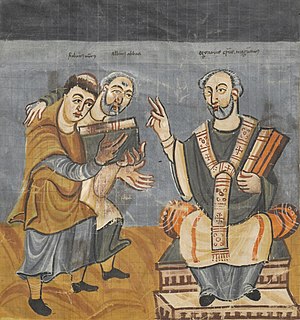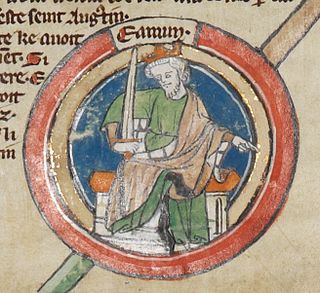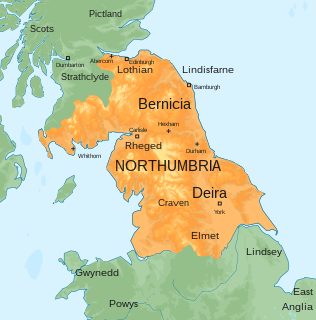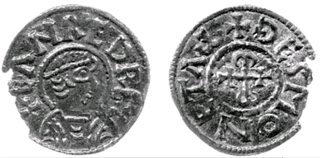
Alcuin of York – also called Ealhwine, Alhwin, or Alchoin – was a Northumbrian scholar, clergyman, poet, and teacher from York, Northumbria. He was born around 735 and became the student of Archbishop Ecgbert at York. At the invitation of Charlemagne, he became a leading scholar and teacher at the Carolingian court, where he remained a figure in the 780s and 790s. "The most learned man anywhere to be found", according to Einhard's Life of Charlemagne, he is considered among the most important intellectual architects of the Carolingian Renaissance. Among his pupils were many of the dominant intellectuals of the Carolingian era.

Edmund I or Eadmund I was King of the English from 27 October 939 until his death on 26 May 946. He was the elder son of King Edward the Elder and his third wife, Queen Eadgifu, and a grandson of King Alfred the Great. After Edward died in 924, he was succeeded by his eldest son, Edmund's half-brother Æthelstan. Edmund was crowned after Æthelstan died childless in 939. He had two sons, Eadwig and Edgar, by his first wife Ælfgifu, and none by his second wife Æthelflæd. His sons were young children when he was killed in a brawl with an outlaw at Pucklechurch in Gloucestershire, and he was succeeded by his younger brother Eadred, who died in 955 and was followed by Edmund's sons in succession.

Northumbria was an early medieval Anglo-Saxon kingdom in what is now Northern England and south-east Scotland.

Ecgberht, also spelled Egbert, Ecgbert, Ecgbriht, Ecgbeorht, and Ecbert, was King of Wessex from 802 until his death in 839. His father was King Ealhmund of Kent. In the 780s, Ecgberht was forced into exile to Charlemagne's court in the Frankish Empire by the kings Offa of Mercia and Beorhtric of Wessex, but on Beorhtric's death in 802, Ecgberht returned and took the throne.

Æthelwulf was King of Wessex from 839 to 858. In 825 his father, King Ecgberht, defeated King Beornwulf of Mercia, ending a long Mercian dominance over Anglo-Saxon England south of the Humber. Ecgberht sent Æthelwulf with an army to Kent, where he expelled the Mercian sub-king and was himself appointed sub-king. After 830, Ecgberht maintained good relations with Mercia, and this was continued by Æthelwulf when he became king in 839, the first son to succeed his father as West Saxon king since 641.

Æthelstan or Athelstan was King of the Anglo-Saxons from 924 to 927 and King of the English from 927 to his death in 939. He was the son of King Edward the Elder and his first wife, Ecgwynn. Modern historians regard him as the first King of England and one of the "greatest Anglo-Saxon kings". He never married and had no children; he was succeeded by his half-brother, Edmund I.

Coenwulf was the King of Mercia from December 796 until his death in 821. He was a descendant of King Pybba, who ruled Mercia in the early 7th century. He succeeded Ecgfrith, the son of Offa; Ecgfrith only reigned for five months, and Coenwulf ascended the throne in the same year that Offa died. In the early years of Coenwulf's reign he had to deal with a revolt in Kent, which had been under Offa's control. Eadberht Præn returned from exile in Francia to claim the Kentish throne, and Coenwulf was forced to wait for papal support before he could intervene. When Pope Leo III agreed to anathematise Eadberht, Coenwulf invaded and retook the kingdom; Eadberht was taken prisoner, was blinded, and had his hands cut off. Coenwulf also appears to have lost control of the kingdom of East Anglia during the early part of his reign, as an independent coinage appears under King Eadwald. Coenwulf's coinage reappears in 805, indicating that the kingdom was again under Mercian control. Several campaigns of Coenwulf's against the Welsh are recorded, but only one conflict with Northumbria, in 801, though it is likely that Coenwulf continued to support the opponents of the Northumbrian king Eardwulf.

Aldfrith was king of Northumbria from 685 until his death. He is described by early writers such as Bede, Alcuin and Stephen of Ripon as a man of great learning. Some of his works and some letters written to him survive. His reign was relatively peaceful, marred only by disputes with Bishop Wilfrid, a major figure in the early Northumbrian church.
Eadburh, also spelled Eadburg, was the daughter of King Offa of Mercia and Queen Cynethryth. She was the wife of King Beorhtric of Wessex, and according to Asser's Life of Alfred the Great she killed her husband by poison while attempting to poison another. She fled to Francia, where she is said to have been offered the chance of marrying Charlemagne, but ruined the opportunity. Instead she was appointed as the abbess of a convent. Here she is said to have fornicated with an English exile. As a result, she was eventually expelled from the monastery and ended her days begging in the streets of Pavia.

Eanred was king of Northumbria in the early ninth century.
Ælla was King of Northumbria, a kingdom in medieval England, during the middle of the 9th century. Sources on Northumbrian history in this period are limited, and so Ælla's ancestry is not known and the dating of the beginning of his reign is questionable.
Eardwulf was king of Northumbria from 796 to 806, when he was deposed and went into exile. He may have had a second reign from 808 until perhaps 811 or 830. Northumbria in the last years of the eighth century was the scene of dynastic strife between several noble families: in 790, king Æthelred I attempted to have Eardwulf assassinated. Eardwulf's survival may have been viewed as a sign of divine favour. A group of nobles conspired to assassinate Æthelred in April 796 and he was succeeded by Osbald: Osbald's reign lasted only twenty-seven days before he was deposed and Eardwulf became king on 14 May 796.
Cyneberht was a medieval Bishop of Winchester. He was consecrated between 781 and 785. In 801 he accompanied Archbishop Æthelhard of Canterbury to Rome. Cyneberht died between 801 and 803.
The Historia Regum is a historical compilation attributed to Symeon of Durham, which presents material going from the death of Bede until 1129. It survives only in one manuscript compiled in Yorkshire in the mid-to-late 12th century, though the material is earlier. It is an often-used source for medieval English and Northumbrian history. The first five sections are now attributed to Byrhtferth of Ramsey..
The Northumbrian Renaissance or Northumbria's Golden Age is the name given to a period of cultural flowering in the Anglo-Saxon kingdom of Northumbria, broadly speaking from the mid-seventh to the mid-eighth centuries. It is characterised by a blend of insular art, Germanic art and Mediterranean influence. Authors associated with this golden age include Bede and Alcuin; artefacts include the Lindisfarne Gospels and associated manuscripts, the Ruthwell Cross and associated sculptures, and, arguably, the Franks Casket. An illustration of the cultural activity of Northumbria during this period is given by Alcuin's De Sanctis et Pontificibus Ecclesiæ Eboracensis, which gives particular attention to Bishop Æthelbert of York.

The Easby Cross is an Anglo-Saxon sandstone standing cross from 800–820, now in the Victoria and Albert Museum, London. It originally came from Easby near Richmond in the Richmondshire district of North Yorkshire, where a plaster replica is kept in the church. Easby was then in the Kingdom of Northumbria. The width of the long faces at the bottom of the lowest fragment is 31 cm (12 in), with a depth of 18 cm (7.1 in), and the whole cross would originally have been up to 3 metres (9.8 ft) high.
Urbs Iudeu was a city besieged in 655 AD by Penda, King of Mercia, and Cadafael, King of Gwynedd. The siege was an important episode in a long-running war between Mercia and Northumbria in the years 616–679. This war was fought in the area north of the River Trent, in particular in and around the Peak District (Wirksworth) also around Heathfield (Doncaster), Elmet (Aberford) and Lindsey (Lincoln), as these were provinces of Northumbria at the time.

In modern contexts Northumbria usually refers to the region of England between the Tees and Tweed, including to the historic counties of Northumberland and Durham, but may also be taken to be synonymous with North East England. The area corresponds to the rump lands of the historical Kingdom of Northumbria, which later developed into the late medieval county of Northumberland or Comitatus Northumbriae, whose original southern boundary was the River Tees. A representative provincial flag of Northumbria is registered for the area.

Cathwulf was an Anglo-Saxon learned man active in Francia. He is known only from a letter he wrote to Charlemagne around 775.
The Chronicle of 957 is an anonymous Latin chronicle of Northumbria and the Kingdom of York covering the years 888–957. It is preserved in the manuscript Cambridge CCC 139 as a part of the 12th-century History of the Kings attributed to Symeon of Durham. There it functions as a continuation, after a long gap, of the Old Northumbrian Annals that cover the years 732–806 and some annals drawn from Asser's Life of Alfred for 849–887. The two Northumbrian chronicles are, however, entirely independent. The Chronicle of 957 is not contemporary with the events it describes, but was composed much later based on a now lost source. It ends with a note about the reign of Edward the Confessor (1042–1066).












